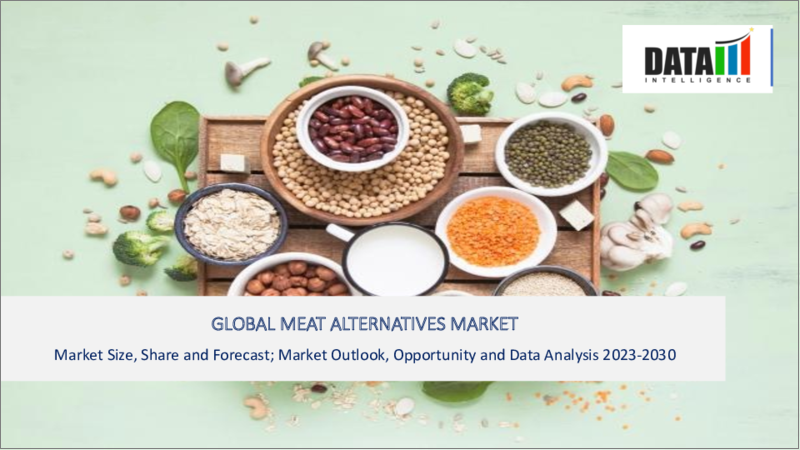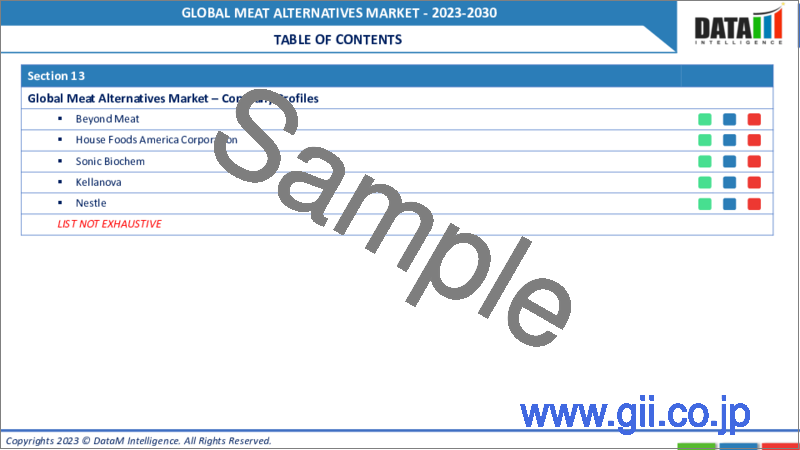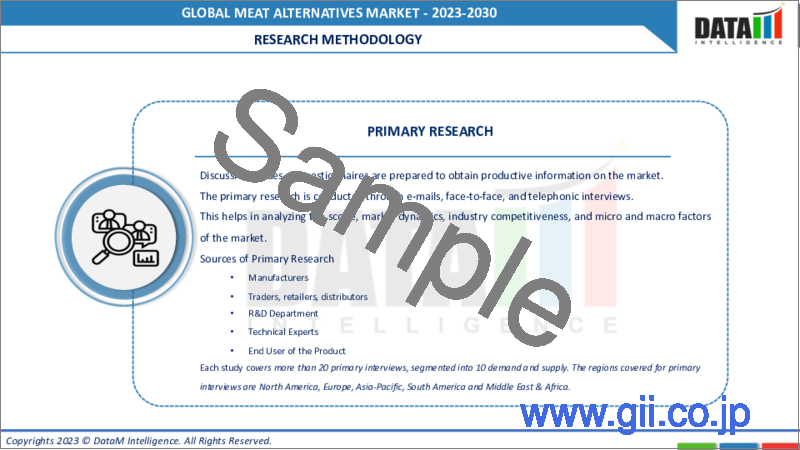|
|
市場調査レポート
商品コード
1290424
代替肉の世界市場- 2023-2030Global Meat Alternatives Market - 2023-2030 |
||||||
カスタマイズ可能
適宜更新あり
|
|||||||
| 代替肉の世界市場- 2023-2030 |
|
出版日: 2023年06月12日
発行: DataM Intelligence
ページ情報: 英文 200 Pages
納期: 即日から翌営業日
|
- 全表示
- 概要
- 目次
市場概要
世界の代替肉市場は、2022年に96億米ドル、2030年には最大208億米ドルに達し、有利な成長を示すと予測されています。2023-2030年の予測期間中、市場はCAGR 10.2%で成長しています。
代替肉は、健康への懸念、環境意識、倫理的配慮など、さまざまな要因から近年人気を博しています。肉代替食品は、ヴィーガン・ラザニアやシェパーズパイなど、伝統的な肉料理の植物性バージョンを作るために使用されます。代替肉は、ベジタリアンやビーガンの食事に取り入れたり、肉の消費量を減らすために使用することができます。
代替肉は、従来の肉よりも飽和脂肪やカロリーが低いことが多く、タンパク質、食物繊維、その他の必須栄養素の供給源となります。代替肉の生産は一般的に、従来の肉生産よりも水や土地の使用量が少なく、温室効果ガスの排出量も少ないため、環境への影響も少ないとされています。代替肉は、動物の屠殺を必要としないため、従来の肉に代わる残酷な代替品となり得るのです。
市場力学
技術的進歩が代替肉市場の成長を牽引
技術の進歩は、すでに代替肉市場の成長を牽引しており、今後もその傾向は続くと予想されます。これらの進歩により、より現実的で栄養価の高い植物性代替食品の生産が可能になると同時に、生産プロセスの効率と持続可能性も向上します。
代替肉市場における技術進歩の一例として、3Dプリンティング技術の開拓が挙げられます。この技術は、肉の食感や外観を再現した植物性代替食品の製造に利用できるほか、よりカスタマイズされた精密な製造の可能性も秘めています。
代替肉市場における従来の肉生産者とのコラボレーションの増加が代替肉市場を活性化させると予想される
従来の食肉生産者とのコラボレーションは、代替肉市場に大きなチャンスをもたらします。既存の食肉生産者と提携することで、代替肉企業はその専門知識とインフラを活用し、生産規模の拡大、流通の改善、より多くの人々へのリーチを図ることができます。さらに、伝統的な食肉生産者は、製品ラインを多様化し、植物由来の代替食品への需要の高まりに対応することができます。
もう一つの例は、Impossible Foodsと、食肉製品の世界サプライヤーであるOSI Groupとのパートナーシップです。2020年、OSIグループは、植物性原料を使用したImpossible Burgersを自社の施設の1つで生産すると発表しました。
COVID-19の影響分析
COVID-19分析では、COVID前シナリオ、COVIDシナリオ、COVID後シナリオに加え、価格力学(COVID前シナリオと比較したパンデミック中・後の価格変動を含む)、需要-供給スペクトラム(取引制限、ロックダウン、その後の問題による需要と供給のシフト)、政府の取り組み(政府組織による市場、セクター、産業の活性化に関する取り組み)、メーカー戦略的取り組み(メーカーはCOVID問題の軽減のために何を行ったか)についても解説します。
目次
第1章 調査手法と範囲
- 調査手法
- 調査目的および調査範囲
第2章 定義と概要
第3章 エグゼクティブサマリー
第4章 市場力学
- 影響要因
- 促進要因
- 抑制要因
- 機会
- 影響分析
第5章 産業分析
- ポーターのファイブフォース分析
- サプライチェーン分析
- 価格分析
- 法規制の分析
第6章 COVID-19の分析
第7章 タイプ別
- 豆腐
- テンペ
- テクスチャード植物性たんぱく質
- その他
第8章 種類別
- 大豆
- 小麦
- マイコプロテイン
- その他
第9章 流通チャネル別
- スーパーマーケット/ハイパーマーケット
- コンビニエンスストア
- オンライン販売
- その他
第10章 地域別
- 北米
- 米国
- カナダ
- メキシコ
- 欧州
- ドイツ
- 英国
- フランス
- イタリア
- スペイン
- その他欧州
- 南米
- ブラジル
- アルゼンチン
- その他南米地域
- アジア太平洋地域
- 中国
- インド
- 日本
- オーストラリア
- その他アジア太平洋地域
- 中東・アフリカ地域
第11章 競合情勢
- 競合シナリオ
- 市況/シェア分析
- M&A(合併・買収)分析
第12章 企業プロファイル
- Garden Protein International
- 会社概要
- 製品ポートフォリオと説明
- 財務概要
- 主な発展状況
- Vbites
- MGP Ingredients
- Monde Nissin Corporation
- Premier Foods
- ADM
- DuPont
- Meatless BV
- Cauldron Foods
- AMY's Kitchen Inc.
第13章 付録
Market Overview
The Global Meat Alternatives Market US$ 9.6 billion in 2022 and is projected to witness lucrative growth by reaching up to US$ 20.8 billion by 2030. The market is growing at a CAGR of 10.2% during the forecast period 2023-2030.
Meat alternatives have gained popularity in recent years due to various factors, including health concerns, environmental awareness, and ethical considerations. They can be used to make plant-based versions of traditional meat dishes, such as vegan lasagna or shepherd's pie. Meat alternatives can be incorporated into a vegetarian or vegan diet or used to reduce meat consumption.
Meat alternatives are often lower in saturated fat and calories than traditional meat and can provide a source of protein, fiber, and other essential nutrients. The production of meat alternatives generally has a lower environmental impact than traditional meat production, as it requires less water and land and produces fewer greenhouse gas emissions. Meat alternatives can be a cruelty-free alternative to traditional meat, as they do not require the slaughter of animals.
Market Dynamics
Technological Advancements are Anticipated to Grow the Meat Alternatives Market's Growth
Technological advancements have already been driving the growth of the meat alternatives market and are expected to continue doing so in the future. These advancements enable the production of more realistic and nutritious plant-based alternatives while also improving the efficiency and sustainability of the production process.
One example of technological advancements in the meat alternatives market is the development of 3D printing technology. This technology can be used to create plant-based alternatives that replicate the texture and appearance of meat, while also offering the potential for more customized and precise production.
An Increase in Collaboration With Traditional Meat Producers in the Meat Alternatives Market is Expected to Fuel the Meat Alternatives Market
Collaboration with traditional meat producers presents a significant opportunity for the meat alternatives market. By partnering with established meat producers, meat alternatives companies can leverage their expertise and infrastructure to scale up production, improve distribution, and reach a wider audience. Additionally, traditional meat producers can diversify their product lines and tap into the growing demand for plant-based alternatives.
Another example is the partnership between Impossible Foods and OSI Group, a global supplier of meat products. In 2020, OSI Group announced that it would be producing Impossible Burgers made from plant-based ingredients at one of its facilities.
COVID-19 Impact Analysis
The COVID-19 Analysis includes Pre-COVID Scenario, COVID Scenario and Post-COVID Scenario along with Pricing Dynamics (Including pricing change during and post-pandemic comparing it with pre-COVID scenarios), Demand-Supply Spectrum (Shift in demand and supply owing to trading restrictions, lockdown, and subsequent issues), Government Initiatives (Initiatives to revive market, sector or Industry by Government Bodies) and Manufacturers Strategic Initiatives (What manufacturers did to mitigate the COVID issues will be covered here).
Segment Analysis
The Global Meat Alternatives Market is segmented based on type, source, distribution channel, and region.
By Source, the Soy Segment Leads the Meat Alternatives Market
The soy segment is currently the largest in the meat alternatives market, accounting for the majority of the market share. Soy-based products have been a popular meat alternative for many years and offer a variety of nutritional benefits, including being a source of protein, fiber, and vitamins.
According to Wikipedia, the total world production for soybeans in 2020 was 353,463,735 metric tonnes, up by 5.1% from 336,329,392 tonnes in 2019. These are the factors that support the soy segment to make exponential growth.
Geographical Analysis
Asia Pacific is the Fastest-Growing Market in the Meat Alternatives Industry
Asia Pacific is the fastest-growing market in the meat alternatives industry due to various factors, including the growing population, increasing health consciousness among consumers, and the rising demand for sustainable and plant-based food options. According to Statista, approximately 19.6 million tons of soybeans are being produced in China and approximately 150 tons of soybeans are being produced in Pakistan. This information shows how Asia Pacific is developing in the meat alternatives market.
Competitive Landscape
The major global players include: the Meat Alternatives market are Garden Protein International, Vbites, MGP Ingredients, Monde Nissin Corporation, Premier Foods, ADM, DuPont, Meatless BV, Cauldron Foods, and AMY's Kitchen Inc.
Why Purchase the Report?
- To visualize the global meat alternatives market segmentation based on type, source, distribution channel, and distribution channel to understand key commercial assets and players.
- Identify commercial opportunities by analyzing trends and co-development.
- Excel data sheet with numerous meat alternatives market-level data points with all segments.
- PDF report consists of a comprehensive analysis after exhaustive qualitative interviews and an in-depth study.
- Product mapping available as Excel consisting of key products of all the major players.
The Global Meat Alternatives Market Report Would Provide Approximately 61 Tables, 60 Figures And 200 pages.
Target Audience 2023
- Manufacturers/ Buyers
- Industry Investors/Investment Bankers
- Research Professionals
- Emerging Companies
Table of Contents
1. Methodology and Scope
- 1.1. Research Methodology
- 1.2. Research Objective and Scope of the Report
2. Definition and Overview
3. Executive Summary
- 3.1. Snippet by Type
- 3.2. Snippet by Source
- 3.3. Snippet by Distribution Channel
- 3.4. Snippet by Region
4. Dynamics
- 4.1. Impacting Factors
- 4.1.1. Drivers
- 4.1.2. Restraints
- 4.1.3. Opportunity
- 4.1.4. Impact Analysis
5. Industry Analysis
- 5.1. Porter's Five Force Analysis
- 5.2. Supply Chain Analysis
- 5.3. Pricing Analysis
- 5.4. Regulatory Analysis
6. COVID-19 Analysis
- 6.1. Analysis of COVID-19
- 6.1.1. Scenario Before COVID-19
- 6.1.2. Scenario During COVID-19
- 6.1.3. Post COVID-19 and Future Scenario
- 6.2. Pricing Dynamics Amid COVID-19
- 6.3. Demand-Supply Spectrum
- 6.4. Government Initiatives Related to the Market During Pandemic
- 6.5. Manufacturers Strategic Initiatives
- 6.6. Conclusion
7. By Type
- 7.1. Introduction
- 7.1.1. Market Size Analysis and Y-o-Y Growth Analysis (%), By Type
- 7.1.2. Market Attractiveness Index, By Type
- 7.2. Tofu*
- 7.2.1. Introduction
- 7.2.2. Market Size Analysis and Y-o-Y Growth Analysis (%)
- 7.3. Tempeh
- 7.4. Textured Vegetable Protein
- 7.5. Others
8. By Type
- 8.1. Introduction
- 8.1.1. Market Size Analysis and Y-o-Y Growth Analysis (%), By Source
- 8.1.2. Market Attractiveness Index, By Source
- 8.2. Soy*
- 8.2.1. Introduction
- 8.2.2. Market Size Analysis and Y-o-Y Growth Analysis (%)
- 8.3. Wheat
- 8.4. Mycoprotein
- 8.5. Others
9. By Distribution Channel
- 9.1. Introduction
- 9.1.1. Market Size Analysis and Y-o-Y Growth Analysis (%), By Distribution Channel
- 9.1.2. Market Attractiveness Index, By Distribution Channel
- 9.2. Supermarkets/Hypermarkets*
- 9.2.1. Introduction
- 9.2.2. Market Size Analysis and Y-o-Y Growth Analysis (%)
- 9.3. Convenience Stores
- 9.4. Online Sales
- 9.5. Others
10. By Region
- 10.1. Introduction
- 10.1.1. Market Size Analysis and Y-o-Y Growth Analysis (%), By Region
- 10.1.2. Market Attractiveness Index, By Region
- 10.2. North America
- 10.2.1. Introduction
- 10.2.2. Key Region-Specific Dynamics
- 10.2.3. Market Size Analysis and Y-o-Y Growth Analysis (%), By Type
- 10.2.4. Market Size Analysis and Y-o-Y Growth Analysis (%), By Source
- 10.2.5. Market Size Analysis and Y-o-Y Growth Analysis (%), By Distribution Channel
- 10.2.6. Market Size Analysis and Y-o-Y Growth Analysis (%), By Country
- 10.2.6.1. The U.S.
- 10.2.6.2. Canada
- 10.2.6.3. Mexico
- 10.3. Europe
- 10.3.1. Introduction
- 10.3.2. Key Region-Specific Dynamics
- 10.3.3. Market Size Analysis and Y-o-Y Growth Analysis (%), By Type
- 10.3.4. Market Size Analysis and Y-o-Y Growth Analysis (%), By Source
- 10.3.5. Market Size Analysis and Y-o-Y Growth Analysis (%), By Distribution Channel
- 10.3.6. Market Size Analysis and Y-o-Y Growth Analysis (%), By Country
- 10.3.6.1. Germany
- 10.3.6.2. The UK
- 10.3.6.3. France
- 10.3.6.4. Italy
- 10.3.6.5. Spain
- 10.3.6.6. Rest of Europe
- 10.4. South America
- 10.4.1. Introduction
- 10.4.2. Key Region-Specific Dynamics
- 10.4.3. Market Size Analysis and Y-o-Y Growth Analysis (%), By Type
- 10.4.4. Market Size Analysis and Y-o-Y Growth Analysis (%), By Source
- 10.4.5. Market Size Analysis and Y-o-Y Growth Analysis (%), By Distribution Channel
- 10.4.6. Market Size Analysis and Y-o-Y Growth Analysis (%), By Country
- 10.4.6.1. Brazil
- 10.4.6.2. Argentina
- 10.4.6.3. Rest of South America
- 10.5. Asia-Pacific
- 10.5.1. Introduction
- 10.5.2. Key Region-Specific Dynamics
- 10.5.3. Market Size Analysis and Y-o-Y Growth Analysis (%), By Type
- 10.5.4. Market Size Analysis and Y-o-Y Growth Analysis (%), By Source
- 10.5.5. Market Size Analysis and Y-o-Y Growth Analysis (%), By Distribution Channel
- 10.5.6. Market Size Analysis and Y-o-Y Growth Analysis (%), By Country
- 10.5.6.1. China
- 10.5.6.2. India
- 10.5.6.3. Japan
- 10.5.6.4. Australia
- 10.5.6.5. Rest of Asia-Pacific
- 10.6. Middle East and Africa
- 10.6.1. Introduction
- 10.6.2. Key Region-Specific Dynamics
- 10.6.3. Market Size Analysis and Y-o-Y Growth Analysis (%), By Type
- 10.6.4. Market Size Analysis and Y-o-Y Growth Analysis (%), By Source
- 10.6.5. Market Size Analysis and Y-o-Y Growth Analysis (%), By Distribution Channel
11. Competitive Landscape
- 11.1. Competitive Scenario
- 11.2. Market Positioning/Share Analysis
- 11.3. Mergers and Acquisitions Analysis
12. Company Profiles
- 12.1. Garden Protein International *
- 12.1.1. Company Overview
- 12.1.2. Product Portfolio and Description
- 12.1.3. Financial Overview
- 12.1.4. Key Developments
- 12.2. Vbites
- 12.3. MGP Ingredients
- 12.4. Monde Nissin Corporation
- 12.5. Premier Foods
- 12.6. ADM
- 12.7. DuPont
- 12.8. Meatless BV
- 12.9. Cauldron Foods
- 12.10. AMY's Kitchen Inc.
LIST NOT EXHAUSTIVE
13. Appendix
- 13.1. About Us and Services
- 13.2. Contact Us





